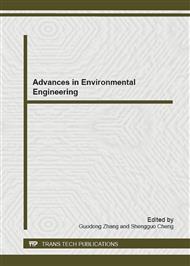[1]
Bi X., Simoneit B.R., Sheng G., Ma S., Fu J. Composition and major sources of organic compounds in urban aerosols. Atmospheric Research 88, 256-265(2008).
DOI: 10.1016/j.atmosres.2007.11.017
Google Scholar
[2]
Kawamura K., Ikushima K. Seasonal changes in the distribution of dicarboxylic acids in the urban atmosphere. Environmental Science and Technology 27.2227-2235(1993).
DOI: 10.1021/es00047a033
Google Scholar
[3]
Sempere K., Kawamura K. Comparative distributions of dicarboxylic acids and related polar compounds in snow, rain and aerosols from urban atmospheres [J].Atmos Environ. 28:449- 459(1994).
DOI: 10.1016/1352-2310(94)90123-6
Google Scholar
[4]
X.L. Tang. Analysis and source appointment of extracal organic acids in TSP of Guangdong. Environment science in China.31(10):1592~1599(2001).
Google Scholar
[5]
Limbeck A. Organic aids in continental background aerosols[J].Atmos Environ. 33: 1847一1852(2009).
Google Scholar
[6]
Zheng M., Fang M., Wang F., To K.L. Characterization of the solvent extractable organic compounds in PM2.5 aerosols in Hong Kong[J].Atmospheric Environment, 34, p.2691~2702 (2000).
DOI: 10.1016/s1352-2310(99)00521-x
Google Scholar
[7]
Yu S.,Zhang Y.H. Xie S.D. Zeng L.M. Zheng M.,Salmon Lynn.G.,Shao M.,Slanina Sjaak.Source apportionment of PM2.5 in Beijing by positive matrix factorization[J]. Atmospheric Environment, 40, 006, p.1526~1537(2003)
DOI: 10.1016/j.atmosenv.2005.10.039
Google Scholar
[8]
Yan B., Zheng M., Hu Y., Ding X., Sullivan A.P, Weber R.J., Baek J., Edgerton E.S,Russell, A.G., Roadside, urban, and rural comparison of primary and secondary organic molecular markers in ambient PM2.5. Environmental Science and Technology 43, 42874293(2009).
DOI: 10.1021/es900316g
Google Scholar
[9]
Decesari S., Facchini E., Matta F.,et al. Chemical features and seasonal variation of fine aerosol water-soluble organic compounds in the Po Valley, Italy. Atmospheric Environment. 35:3691-3699 (2001).
DOI: 10.1016/s1352-2310(00)00509-4
Google Scholar
[10]
Li C.L., Fu J.M., Sheng G.Y., Bi X.H., Hao Y.M., Wang X.M., Mai B.X., Vertical distribution of PAHs in the indoor and outdoor PM2.5 in Guangzhou, China[J]. Building and Environment., 40,p.329~341(2005).
DOI: 10.1016/j.buildenv.2004.05.015
Google Scholar
[11]
X.Q. Guo, Y.F. Wang, X.R.Li, Y.S. Wang. Characteristics of organic acids in PM2.5 in Beijing during Spring Festival of 2007. The 5th Mainland-Taiwan aresols Conference. Sep.2-6 2008,93~99.
Google Scholar
[12]
Jiang Y L, Hou X M, Zhuang G S, et al. The sources and seasonal variations of organic compounds in PM2.5 in Beijing and Shanghai, Journal of Atmospheric Chemistry, 62(3): 175-192(2009).
DOI: 10.1007/s10874-010-9147-0
Google Scholar
[13]
Wang Y., Zhuang G.S., Chen S. Characteristics and sources of formic , acetic and oxalic acids in PM2.5 and PM10 aerosols in Beijing, China [J]. Atmospheric Research,84(2):169-181(2007).
DOI: 10.1016/j.atmosres.2006.07.001
Google Scholar
[14]
F.K. Duan, K.B.He, X.D. Liu. Characteristics of organic acids of PM2.5 in Beijing[J]. Environment science,29(6):1139-1145(2009).
Google Scholar
[15]
C.S. Liu, X.R.Li, S.S. Zhang. X.Q. Guo. S.Y. Wang. Source appointment and seasonal variations of fatty acids in particulate matter of Beijing. Environment science in China. 29(7):673~678(2009).
Google Scholar
[16]
Zheng M., Fang M., Wang F., et al. Characterization of the solvent extractable organic compounds in PM2.5 aerosols in Hong Kong [J]. Atmospheric Environment, 34(17):2691-2702 (2000).
DOI: 10.1016/s1352-2310(99)00521-x
Google Scholar
[17]
Oliveira C., Alves C., et al. Seasonal distribution of polar organic compounds in the urban atmosphere of two large cities from the north and south of Europe[J]. Atmospheric Euviroumeut, 41( 27): 5555 5570(2007).
DOI: 10.1016/j.atmosenv.2007.03.001
Google Scholar
[18]
Norton R. B., Roberts J. M., Huebert B. J. Tropospheric oxalate[J]. Geophys Res Let, 10:517~520(2003).
Google Scholar
[19]
Oliveira C, Pio C., Alves C., et al. Seasonal distribution of polar organic compounds in the urban atmosphere of two large cities from the north and south of Europe [J]. Atmospheric Envirorunent,41(27):5555-5570(2007).
DOI: 10.1016/j.atmosenv.2007.03.001
Google Scholar


